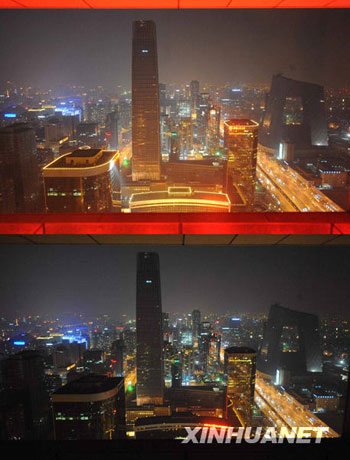Lights went out at landmark buildings and homes across the world on Saturday for Earth Hour 2009, part of a global initiative to highlight the threat of climate change.
 |
|
A combination picture shows the downtown Beijng before and after the lights were turned off for Earth Hour March 28, 2009. About 20 Chinese cities joined a worldwide campaign to persuade the public to switch off unnecessary lights for one hour Saturday night to support energy-saving efforts and show concerns about global warming. [Luo Xiaoguang/Xinhua]
|
Time zone by time zone, some 4,000 cities and towns in 88 countries and regions joined the global event initiated by the World Wildlife Fund to dim nonessential lights from 8:30 p.m. to 9:30 p.m.
With diesel generators switched off, the one-hour lights off campaign officially began on the Chatham Islands, a small chain some 800 km east of New Zealand.
New Zealand became one of the first countries to switch off the power. Auckland's Sky Tower, the Beehive (parliament building) in Wellington and Christchurch's Cathedral Square were some of the country's landmarks taking part.
In Antarctica, New Zealand's 26-member winter team at Scott Base, where temperatures are close to minus 30 degrees Celsius, shut down to minimum safety lighting and switched off all unnecessary appliances and computers.
In Sydney, famous harbor landmarks of Sydney Opera House and the arch-like Harbor Bridge were plunged into darkness on Saturday night, with tens of thousands of residents and businesses also turning their lights off for the global event.
"We need massive change - one hour in terms of change is not that much," the Australian Associated Press reported, quoting Earth Hour director Andy Ridley.
The campaign then went west. Lights at landmarks in South Korea, China, India, Singapore, Thailand and the Philippines were dimmed as people celebrated with candle-lit picnics and concerts.